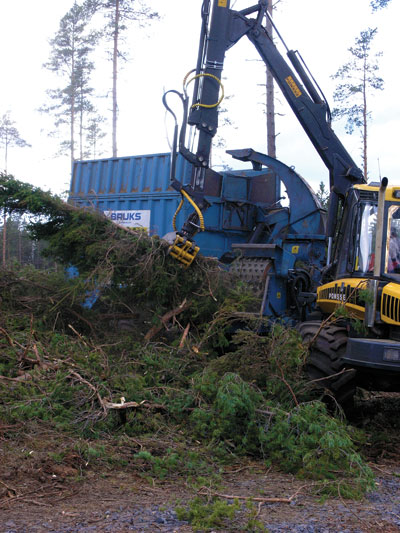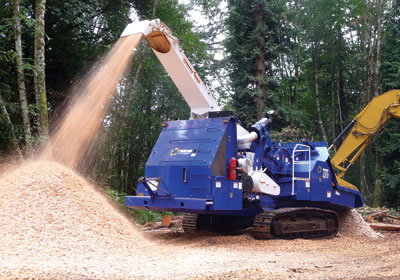
Cleaner Engines
February 10, 2011
By Bruce Barker
The world might be breathing easier, but a lot of diesel engineers are hyperventilating in their efforts to reach the new Tier 4 Interim (IT4) standards for 2011.
The world might be breathing easier, but a lot of diesel engineers are hyperventilating in their efforts to reach the new Tier 4 Interim (IT4) standards for 2011. The new standards for forestry diesel engines will require a 90% reduction in particulate matter (PM) and a 50% drop in nitrous oxide (N2O) compared to Tier 3 regulations. The standards are part of the U.S. Environmental Protection Agency’s (EPA) emission policy for diesel engines, and Canadian biomass harvesters have no choice but to follow along because off-road engines are primarily made in the United States or Europe, where the same standards are being applied.
 |
|
| Off-road diesel engines will have to conform to Tier 4 Interim regulations in 2011.
|
Until 1994, off-road diesel engines were unregulated for vehicle exhaust emissions. That changed when the first of the EPA’s emission standards was implemented. The EPA’s initiative to lower diesel engine emissions goes back to the U.S. Clean Air Act of 1970, passed just after the first Earth Day. First to be regulated were automobiles, followed by on-highway trucks.
Since then, emission standards for off-road diesel engines have steadily become more stringent. The first Tier 1 standard was phased in from 1996 to 2000, and more stringent standards for Tier 2 and Tier 3 were phased in from 2000 to 2008. IT4 standards will be in place in January 2011, with full Tier 4 final standards implemented by 2015. At that point, an additional 80% reduction in N2O will be required compared to IT4 while maintaining PM emissions at IT4 levels.
Roger Hoy, director of the Nebraska Tractor Test Laboratory (NTTL) at the University of Nebraska-Lincoln, has been following the development of the Tier 4 technology closely. He has had a chance to preview some of the new emissions reduction technologies. He is pleased with their performance, but, like other off-road engine experts, has some concerns about the effect on engine efficiency.
“So far, the EPA will tell you that reduction in emissions will increase fuel economy. That is sort of true and sort of false. Applying emissions reductions alone will reduce fuel economy, naturally, but some of the things that manufacturers have introduced at the same time to reduce emissions have improved fuel economy,” says Hoy. “Electronic fuel injection to control emissions has improved fuel economy. We’ve seen two valve heads go to four. When John Deere went from the 8020 series to the 8030 series, they got a huge increase in fuel economy because they redesigned their engine to give it more air. My personal opinion is that going to Tier 4 Interim might be a wash, but going from Tier 4 Interim to Tier 4 final is probably going to lose some fuel economy.”
Hoy explains that several technologies are being used currently for Tier 3 reductions that will be used in Tier 4 Interim reductions. Two that have helped achieve Tier 3 reductions are internal exhaust gas re-circulation (IEGR) and cooled external gas re-circulation (CEGR).
IEGR is primarily used at engine start-up to reduce emissions by recirculating exhaust gases back into the engine for more complete combustion. CEGR cools the gas through a heat exchanger to allow a greater mass of exhaust gases to be recirculated back into the engine.
Two additional technologies
Two other key technologies will help manufacturers meet IT4 reductions: selective catalytic reduction (SCR) and regenerating particulate filter (RPF). They take divergent approaches.
 |
|
| Diesel-powered non-road equipment such as chippers and grinders will also be subject to Tier 4 regulations. Photo: Peterson
|
SCR operates like a catalytic converter on a car. In one such system, a 32% urea solution is sprayed into the exhaust gases as they leave the engine and just before they enter the catalytic converter. Inside the SCR system, the exhaust heat turns the urea into ammonia, which reacts with N2O to produce water vapour and harmless nitrogen gas. “What they have done is say that they aren’t going to worry about some of the emissions within the engines. They will let the N2O go back to a Tier 2 setting, and they are going to take out the N2O with a separate component like the SCR,” explains Hoy.
The urea solution is commonly called diesel exhaust fluid (DEF). It is stored in a separate, refillable tank. “The DEF is a consumable quantity,” says Hoy. “These machines have a separate tank where you might put 5 or 10 gallons of DEF, and if you try to put water in, or don’t fill it, the machinery won’t run, or it de-rates to a point that is so obnoxious that you put the right stuff in.”
Hoy had the opportunity to test the performance of an off-road engine equipped with SCR technology. He found that, depending on operation, DEF consumption was 2–4% of diesel fuel consumption. At an average 3% consumption, an operator using 1,000 litres of fuel could expect to use 30 litres of DEF. “We realize this is an operating cost that should be tracked, just like you do with diesel fuel,” says Hoy.
Overall, though, Hoy explains that the fuel economy with the system he tested was excellent; the engine was allowed to use more fuel-efficient operating modes because it did not have to deal with N2O emissions within the engine.
The other main technology that will be employed to reach IT4 standards is RPF. In many cases, the RPF replaces the muffler, trapping and holding particulates remaining in the exhaust system. Trapped particles are eventually oxidized within the RPF in a process called regeneration. “In this case, the N2O emissions are controlled within the engine without worrying about particulates,” explains Hoy. “What it does with the PM is to replace the muffler with a particulate filter trap. That all sounds nice, but eventually the PM builds up, and periodically, the machine may have to inject diesel fuel into the exhaust system to raise the exhaust gas temperatures up to burn off the particulate that has been trapped.”
“When the filter starts building up soot (PM), the back-pressure in the system starts to go up, and if exhaust gas temperatures aren’t high enough, or not in the right range, this soot won’t convert to ash on its own, so something has to be done to bring it up, so diesel fuel is injected,” explains Hoy. “You might see a change in fuel consumption as these things burn.”
PM is converted to ash during regeneration, and remains inside the filter. The amount of ash accumulated during a period of use will eventually mean the RPF will need replacing after about 3,500 or 4,000 hours.
Engine systems
In the agricultural market that Hoy studies, John Deere is combining a diesel oxidation catalyst (DOC) with RPF (Deere calls it a diesel particulate filter, DPF). The company’s IT4 information says that under normal operating conditions, the DOC reacts with exhaust gases to reduce carbon monoxide, hydrocarbons, and some PM. The downstream RPF forces exhaust gases to flow through porous channel walls, trapping and holding the remaining PM. Trapped particles are eventually oxidized within the RPF through a self-cleaning process called passive regeneration, using exhaust heat created under normal operating conditions. When the exhaust temperature is incapable of oxidizing the PM, the RPF filter reverts to active regeneration with the injection of diesel fuel to help burn off the PM.
Hoy observed a John Deere IT4 engine at a John Deere test facility. He saw that engine torque was within 3/10% between soot load and fully cleaned after regeneration with the RPF system. The Organisation for Economic Co-operation and Development requires test measurement tolerances to be within 0.5–1%, so the Deere result is within the measurement requirements. “I do have the conclusion that Deere has a very well designed system here. There is no guarantee that similar systems from other manufacturers will be well designed, so we are going to ask that that this type of performance information be recorded and supplied to us,” says Hoy. Deere told Canadian Biomass that it will be using the same base technology for all off-road markets, including cut-to-length, bundler, and full-tree systems being marketed in Canada.
For the time being, the Nebraska Tractor Test Lab will not be conducting these additional tests related to the IT4 technology, but will be recording manufacturer results on the NTTL reports. They are currently working at developing the necessary standard tests. The reports will also require mention of any special conditions for regeneration of the RPF. Hoy explains that the Deere system does not require any, and an operator might not even know it is going on, but says, “It is possible, due to a system design, or the operating conditions, that the tractor might force you to stop what you are doing and let the system regenerate. If that is the case, we want it to be identified.”
Joe Mastanduno, product marketing manager, engine/drivetrain, with John Deere Construction and Forestry, adds that when it comes to getting the best durability and reliability from these new IT4 machines, operator and maintenance training at the outset is a good idea. “There are some issues that need attention when using IT4 machines, including using the proper fluids (oil, coolant, fuel) and proper maintenance of the diesel particulate filter. As with any machinery, the proper maintenance and operation is key,” he says, adding that Deere has a bulletin on these issues.
Another major off-road player, Caterpillar, is using a combination of DOC, DPF or RPF, and a Cat regenerative system (CRS) that removes trapped soot. The CRS is controlled electronically and its operation is transparent to the operator.
Buy now or later?
With the two main IT4 technologies now firmly entrenched in most manufacturers’ programs, the choice will be either an SRC or RPF system as the main component. They will likely be seen on virtually every Tier 4 Final engine by 2014, unless some other new technology is developed in the next few years.
For those in the market for new gear, the question might be whether to buy a Tier 3 or IT4. One issue may be cost. Research and development costs are high. The EPA admits there will be an additional cost to equipment, anticipated in the range of 1–3% of the total purchase price for most off-road diesel equipment categories.
Hoy says that IT4 regulations were implemented three years earlier for on-road diesel engines and there was a large pre-buy of diesel trucks in the transport industry. And some bugs had to be worked out of the new technology. However, the off-road sector had three additional years to fine-tune the technology. Whether to wait to purchase the new technology (some 2010 models may already have the technology) may be a matter of personal preference.
Print this page